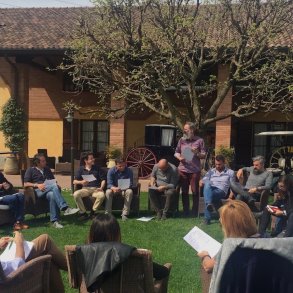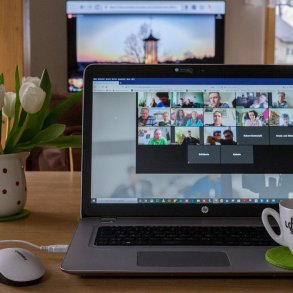By Susan Basterfield and Kate Beecroft and originally published at corporate-rebels.com
“This post is written by Susan Basterfield and Kate Beecroft. Check out their bio below the article.”
Most of the decisions we make are instantaneous, even decisions in the workplace. We don’t think about them, they are reflexive and automatic. Depending on our individual level of autonomy in our livelihood and our work relationships, our level of recognition of the impact our decisions have on others probably varies.
Decisions that are routine and easily made independently (i.e. individually or with the quick input of another person) versus those decisions that benefit from the collective insights of the group may be difficult to recognise.
First steps
A first step could be to start to conceptualise the relative impact and / or complexity of a particular decision. Samantha Slade from Percolab introduced us to a model that helps us understand the impact of decisions to help us understand the optimal level of participation for a particular decision.
Her perspective is “The more a decision has greater risk and greater duration, the more it should be collective (collective input or taken collectively). The more a decision is of short duration and minimal risk, the more it is best left to a person or two.”
How we make decisions in a small team
When the Leadwise team put together our new training: Decision Making in the New Era of Work, we had some choices to make, and agreements to reach. As in any project, some were easy, some more complex.
Our core team (Kate, Ian and Susan) have been working together for around 15 months, and have built a level of trust and confidence. As a self-managing entity, and a self-organised team, we all carry equal status and hold no command authority over one another. We were never going to have to contend with some unhealthy behaviours of a more hierarchical team, like:
- One person relies on their own experience and because they are in a higher pay band their approach is seen as unassailable. (The Corporate Rebels call this HIPPO – Highest Paid Person’s Opinion)
- A decision is made and passed down to the team to execute
- The hierarchy of context leads to mistrust and parenting behaviours
Although the three of us focus on different roles within our core team, it’s expected ideas come from all of us, and no one holds the role of “generator of great ideas”. We are quite different humans, but we’ve practiced being together a lot!
We have fully experienced how tapping into and unleashing our collective intelligence can get us to a much richer solution, and ultimately a better outcome.
- We have shared context and are adept at utilising it to make really good decisions – encompassing knowledge of different types of participants, stakeholders, our broader communities and networks – all of whom are affected in some way
- Because we all contribute to the decision, we all become champions of the process and the outcome and engagement is super high
We weren’t always good at it! We’ve had lots of lived experience and practice with participatory decision making through our entrepreneurs collective, Enspiral. Many years of practice, experiments and mistakes helped us to see patterns and notice what works.
How we make decisions at a collective level
One of the key elements to a super rich collective decision culture is actively encouraging divergent views and even dissent. This helps everyone to be fearless to disagree and bring in new thinking.
The ex-founder of Enspiral, Joshua Vial, is one of my favourite examples of a leader who is is totally open to new thinking, because he understands how it serves the group. After a period of discussion, he’ll revise his decision (or proposal in advance of a decision) to take on the thinking of the group.
A personal aside: at first it was disconcerting to have a robust discussion with Joshua, or take a dissenting position and be ok with it – but almost without fail, he’ll come back in a day or two with a wonderful embodiment of my point of view, or an integrated revision.
This shows:
- Openness for new thinking
- A culture of facilitation
- Trust within the group and of the group
- Ability to not just agree but to use divergence to bring in something better
It is rare for complex decisions in Enspiral to be made quickly – that’s partly because we’ve developed good radar to help us understand what we can ‘just do’ (and therefore don’t need to make into a group process) and what benefits from the input of the collective. When there are straightforward decisions to be made, we use an informal advice process to seek out clarity and ensure robustness.
Thankfully, we have Loomio to help us. As a decentralised, distributed entity, it’s impossible for us to come together physically to make decisions. Loomio is a tool that allows us all to participate not only in the formulation of ideas that may (or may not) lead to decisions, but, perhaps more importantly, make our decision making transparent.
Enspiral has been using Loomio for almost 5 years, and we have a perpetual record of every decision ever made. It’s a fascinating study in how we’ve progressed in our collective practice, and provides a wonderful artefact for new contributors to peruse so they might ‘get the hang of it’.
What are you doing in your team or organisation?
Your organisation might make few decisions collectively, but it’s almost guaranteed that there are more decisions being made than you know. For many, maybe even most, simply making transparent who is accountable for the decision will bring a level of context and confidence.
It’s also quite likely that there are many decisions being made in your organisation that could benefit from the collective intelligence or ‘hive mind’.
We can almost hear the misgivings ‘This is impossible’ and ‘it would take waaaay too long’ or ‘all we’d do is be in meetings’. Please, suspend your disbelief.
Learning how to make great decisions together is something you will need to think about, you need to decide how to decide. Once you’ve made the shift, the benefits of increased context, accountability, and engagement will open the floodgates of abundant perspective, and beautiful decisions.


Susan Basterfield and Kate Beecroft are co-convenors at the LeadWise Academy and members of Bucket List organization Enspiral, a network at the forefront of new ways of working.
Republished with permission.
Featured Image/graphic link added by Enlivening Edge Magazine.





According to the dictionary, “divine” is godly, godlike, angelic, seraphic, saintly, beatific; spiritual, heavenly, celestial, holy.
What does decision-making have to do with that?